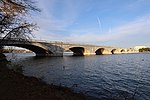Seabees Memorial
1974 establishments in Virginia1974 sculpturesAC with 0 elementsGeorge Washington Memorial ParkwayMilitary monuments and memorials in the United States ... and 7 more
Monuments and memorials in VirginiaNaval monuments and memorialsOutdoor sculptures in VirginiaSculptures of men in VirginiaSeabeesStatues in VirginiaTourist attractions in Arlington County, Virginia

The Seabees Memorial is a sculpture and memorial to Seabees by Felix de Weldon, installed along Memorial Drive near the entrance of Arlington National Cemetery. It is administered by the National Park Service as part of George Washington Memorial Parkway in Arlington, Virginia.Congress authorized the placement of a memorial on public land by the Seabee Memorial Association in September 1972. It was dedicated on Memorial Day 1974.
Excerpt from the Wikipedia article Seabees Memorial (License: CC BY-SA 3.0, Authors, Images).Seabees Memorial
Memorial Avenue, Arlington Rosslyn
Geographical coordinates (GPS) Address Nearby Places Show on map
Geographical coordinates (GPS)
| Latitude | Longitude |
|---|---|
| N 38.88498 ° | E -77.06263 ° |
Address
Seabee Memorial
Memorial Avenue
20566 Arlington, Rosslyn
Virginia, United States
Open on Google Maps








